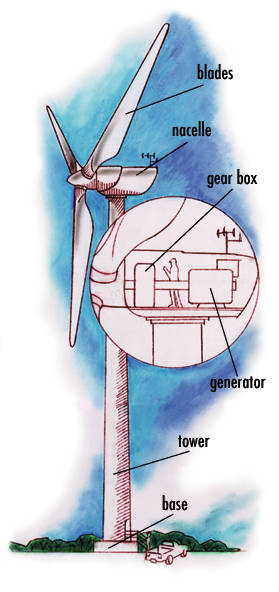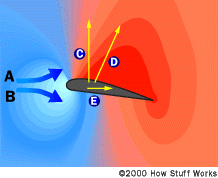 The
Rotor
The
Rotor
The Physics of Wind Turbines
This section gives a quick overview of the parts of a wind turbine and how it works. For more information click here or visit the links page.
The Parts of a Wind Turbine
There are four main parts of a wind turbine: the base, the tower, the nacelle and the rotor (hub and blades assembly). The base acts as an anchor that supports the entire assembly so it doesn't fall over, the tower supports the nacelle and rotor and contains the electrical conduits, the nacelle contains the electric generator that makes the electricity, and the rotor assembly converts the energy of the wind to rotational motion.
 The
Rotor
The
Rotor
The blades of modern wind turbines are aerodynamic wings that create lift as wind blows across them. Older wind turbines use the force of the wind pushing against them to turn. This occurs because the wind is deflected by the blades (since they aren't parallel to the wind), and the force the wind exerts on the blades is converted to motion in the opposite direction. Turbines with aerodynamic wings are more complicated, but they work in a similar manner (see section below). The blades are connected to a central cone called the hub, which is in turn connected to an axle that passes into the nacelle.
The Nacelle
The nacelle is a small room at the top of the tower that contains the axle, the gearbox, the generator and other equipment. The axle passes through the front of the nacelle, into a gearbox and then into the generator. The gearbox can be used to adjust the speed of the axle, depending on the wind speed. The generator creates AC power, which is transported from the nacelle by large cables. Other equipment might also be present, depending on the sophistication of the turbine. Some turbines use electronics to adjust the direction in which the nacelle points, or the pitch angle of the blades, in order to increase the amount of wind energy captured. As well, the nacelle can be reached by ladder so that people can access it in case some of the components need repair.
The Tower
The tower usually consists of a hollow steel cylinder that is 40 to 60 metres tall. Some turbines use a different tower design, using a steel lattice or concrete instead. Inside there is a ladder for access to the nacelle, a hoist for moving equipment to the nacelle, and conduits for the electrical cables.
The Base
The base supports the entire wind turbine assembly, and
it is essential that it be large enough that the turbine will never blow
over. Usually, the base is constructed from concrete, re-inforced with
steel bars. It is usually made in the shape of a large cylinder, around
10 to 15 metres in diameter. This cylinder is buried underground so that
the turbine assembly is well anchored.
How Wind Energy is Converted to Mechanical Energy by the Rotor
This section gives a high level overview of how the blades of the turbine convert energy from the wind into rotational motion of the rotor. For an in-depth description of how this works, click here.
 The
blades of modern wind turbines are similar to airplane wings, in that they
use lift to enhance their conversion of the wind's energy. The way this
works is that as air blows across the blades it splits into two parts -
some of it goes over the top of the blade (A) and some of it goes under
the bottom of the blade (B). The air blowing across the top is compressed
into the air above it. As the air travels further across the blade, it
begins to decompress and the pressure drops, creating a low-pressure area.
This low-pressure area causes the air above it to be sucked down across
the rear of the blade. The air blowing across the bottom of the blade also
gets compressed as it moves across its width, but not to the same extent
as the air above. As the compressed air travels across the blade, its speed
and pressure gradually match that of the wind coming over the top of the
blade. Together, these two effects create the lift (C) that causes the
wind turbine rotor to rotate. Additionally, there is some drag caused by
air friction (E) that slows the blade down, so that the force that is actually
exerted on the blade is in the direction of D.
The
blades of modern wind turbines are similar to airplane wings, in that they
use lift to enhance their conversion of the wind's energy. The way this
works is that as air blows across the blades it splits into two parts -
some of it goes over the top of the blade (A) and some of it goes under
the bottom of the blade (B). The air blowing across the top is compressed
into the air above it. As the air travels further across the blade, it
begins to decompress and the pressure drops, creating a low-pressure area.
This low-pressure area causes the air above it to be sucked down across
the rear of the blade. The air blowing across the bottom of the blade also
gets compressed as it moves across its width, but not to the same extent
as the air above. As the compressed air travels across the blade, its speed
and pressure gradually match that of the wind coming over the top of the
blade. Together, these two effects create the lift (C) that causes the
wind turbine rotor to rotate. Additionally, there is some drag caused by
air friction (E) that slows the blade down, so that the force that is actually
exerted on the blade is in the direction of D.
<< BACK to Solar Array
Demo
Introduction
NEXT to Pinwheel Experiment >>
This site was created by James Rowe, April 2002. You may use any material
from this site, but please give acknowledgement if you do.
If you find any problems with the site, please contact
me
or UBC Physics Outreach.